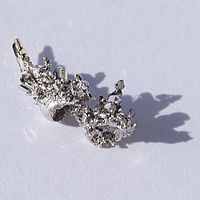
Photo from wikipedia
The many uses of palladium in medicine, catalysts and other industries make it a very important precious element. Many industries using palladium discharge process wastewaters that may release elevated concentrations… Click to show full abstract
The many uses of palladium in medicine, catalysts and other industries make it a very important precious element. Many industries using palladium discharge process wastewaters that may release elevated concentrations of palladium into the environment. This study focused on the recovery of palladium from aqueous solutions by zeolite functionalised with spent brewer's yeast. Batch experimental results were used to calibrate a generalised surface complexation model based on coupling parameter estimation (PEST) to the PHREEQC geochemical modelling code. PHREEQC is an acronym which stands for pH, redox, equilibrium and C programming language. Calibration was based on the determination of sorption constants for the reactions of palladium with the adsorbent. The generalised amine surface groups (derived from yeast), the moles of adsorption sites and surface area were specified. The recovery of palladium was assessed as a function of solution pH, adsorbent dosage and initial concentration of palladium in the presence of other cations and anions at different concentrations. The highest recovery of palladium (>97%) was observed at pH 2 and 10 g L-1 adsorbent dosage which, decreased with increasing solution pH. The amount of palladium removed increased in the presence of competing ions and anions. There was no significant difference (p > 0.05) between the modelled and measured data, which indicated that PHREEQC modelling code coupled with PEST can accurately determine the recovery of palladium using amine-based adsorbents when all the required information is specified. This is very useful in instances where limited experimental data is available for non-conventional and novel surfaces to make accurate predictions of sorption processes involving them.
Journal Title: Journal of environmental management
Year Published: 2020
Link to full text (if available)
Share on Social Media: Sign Up to like & get
recommendations!